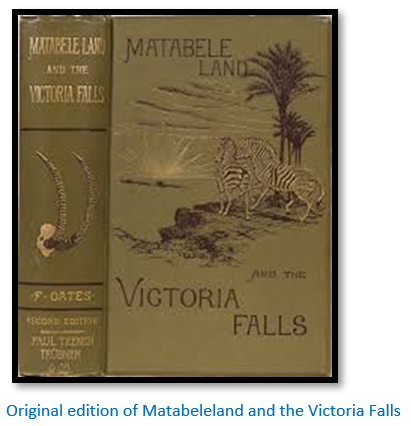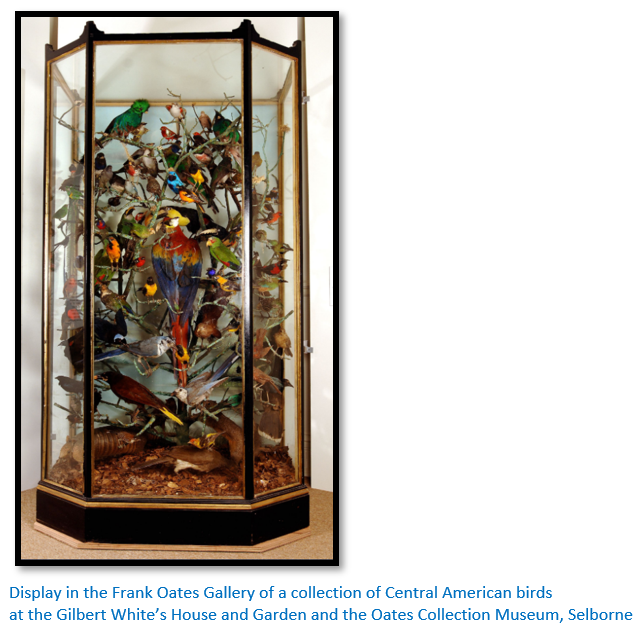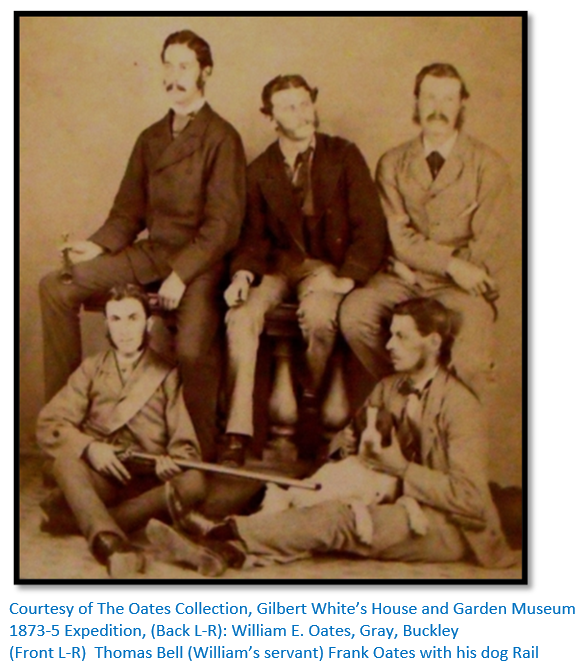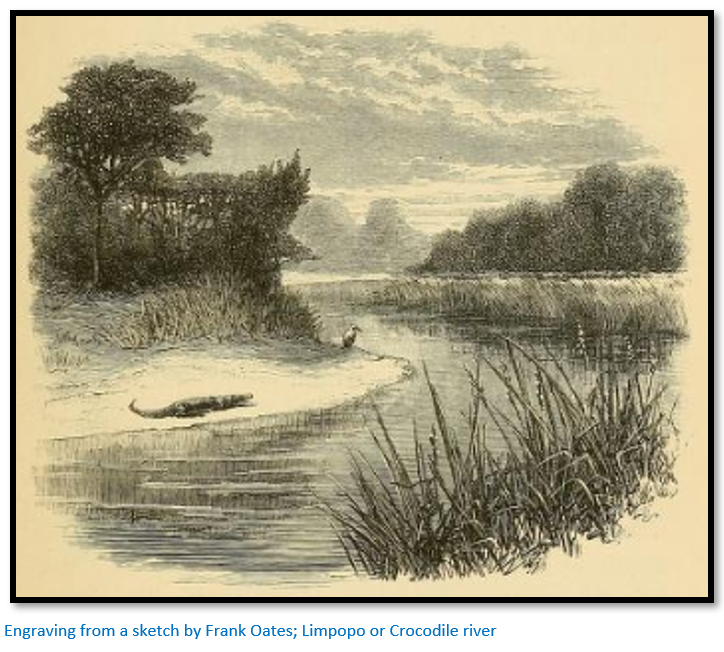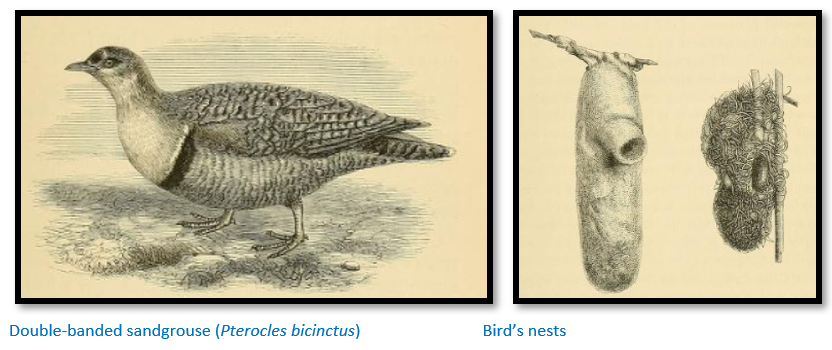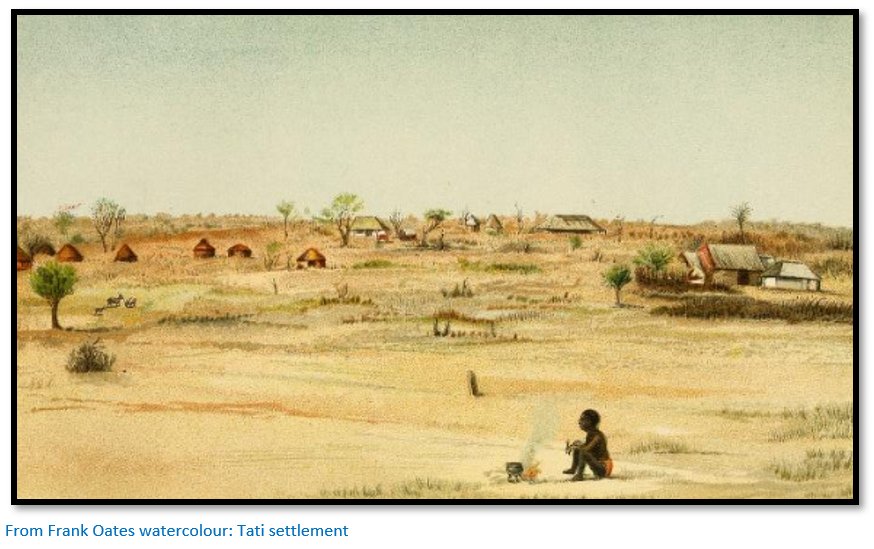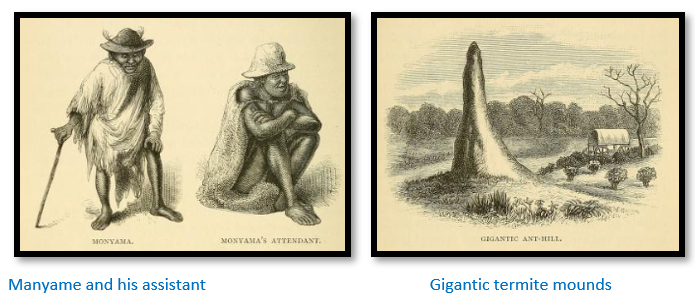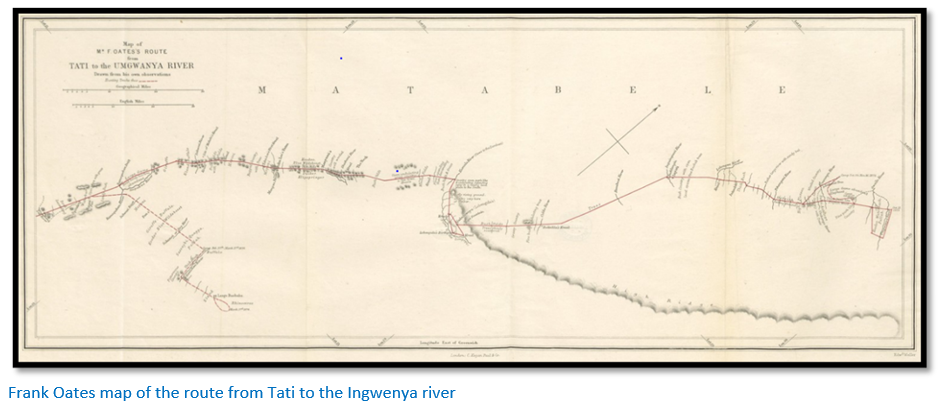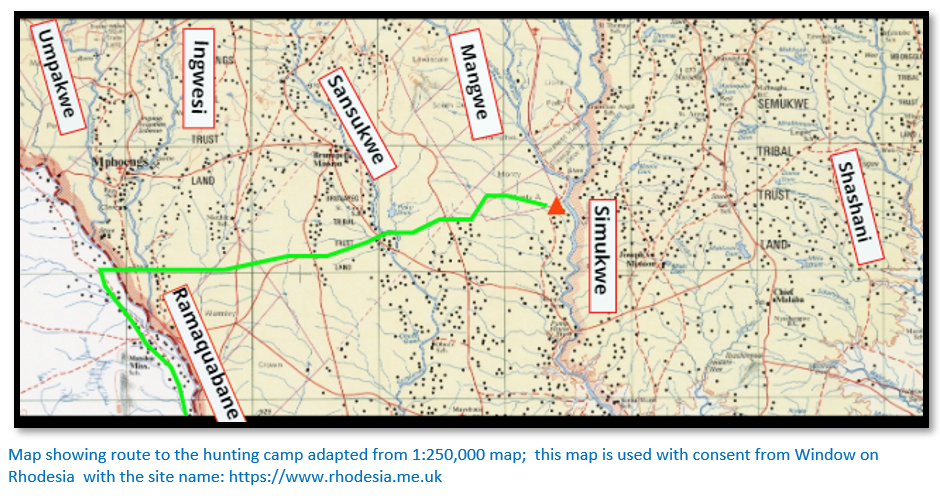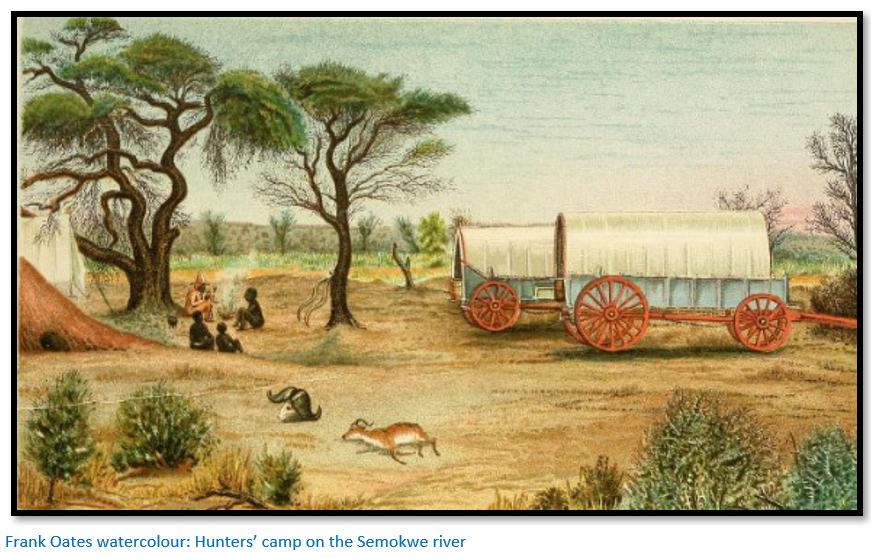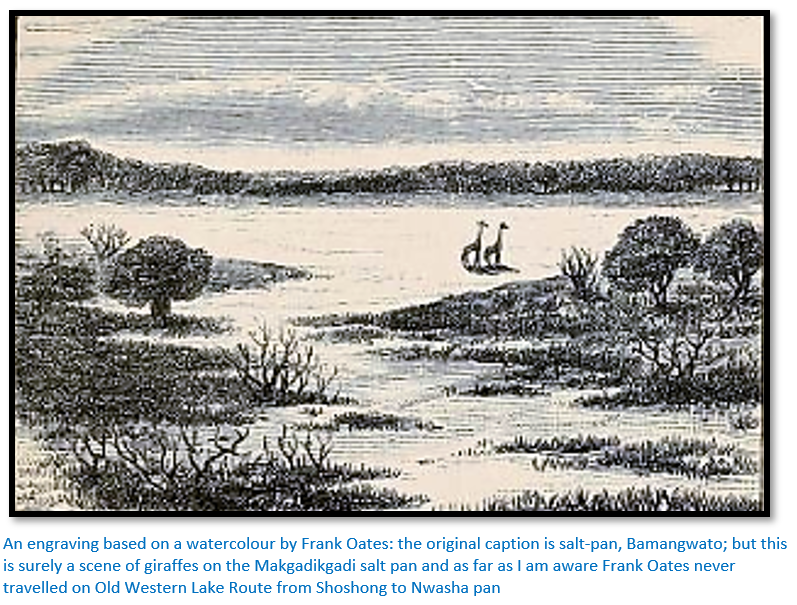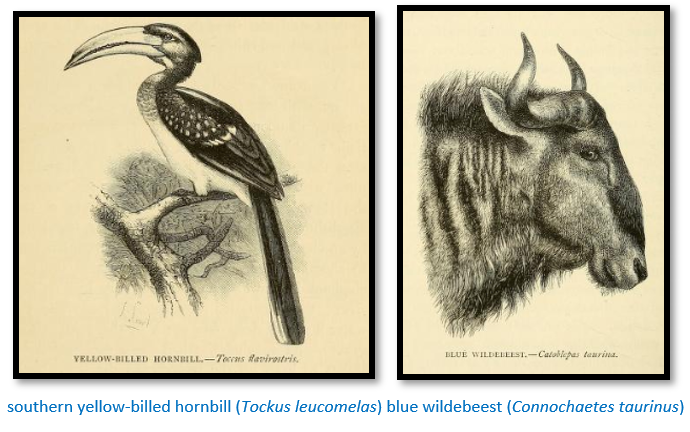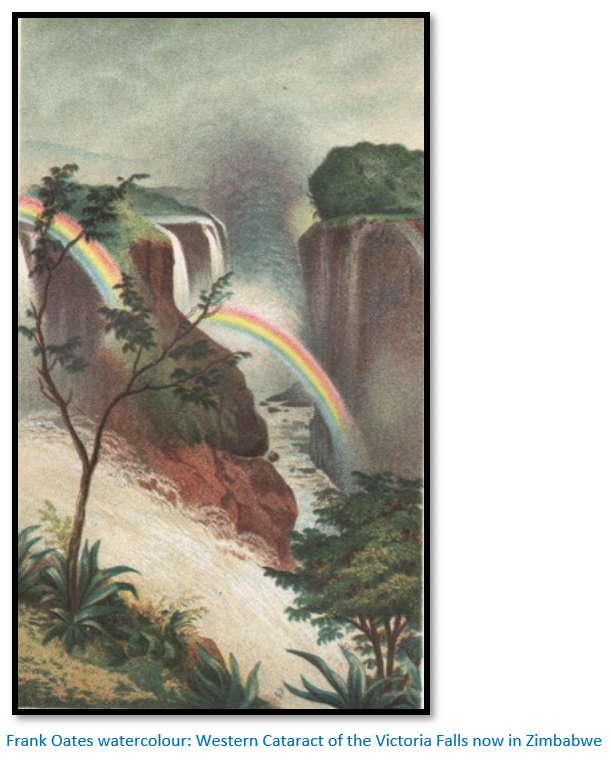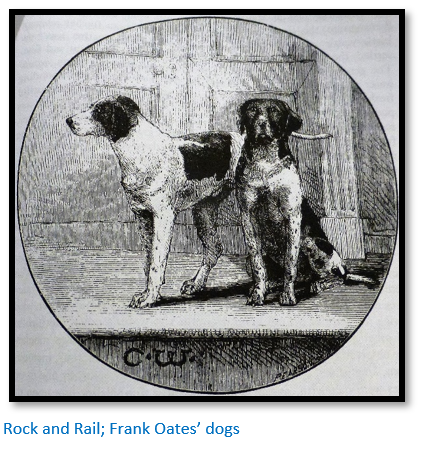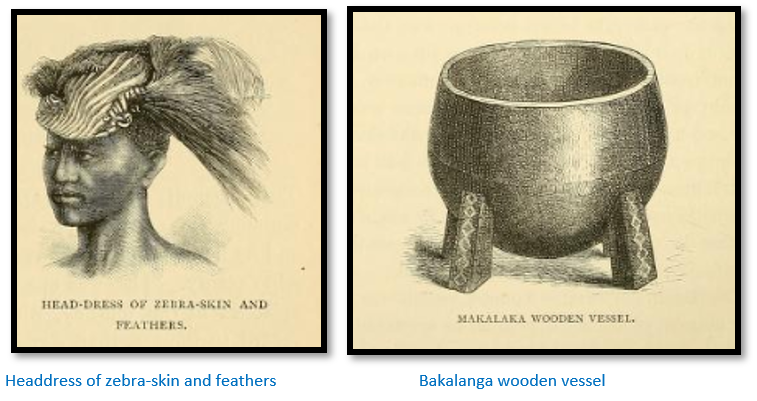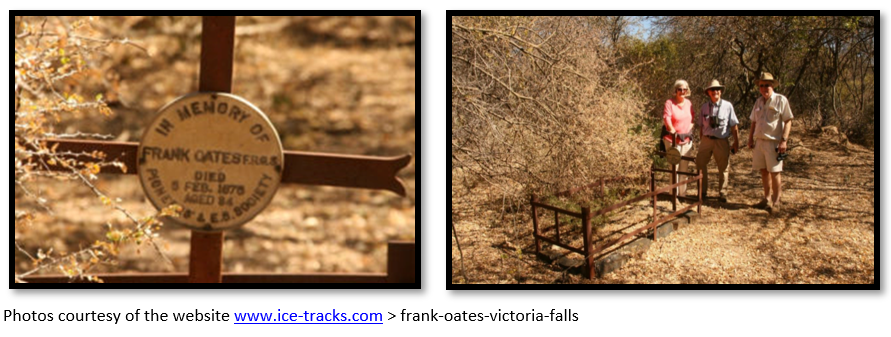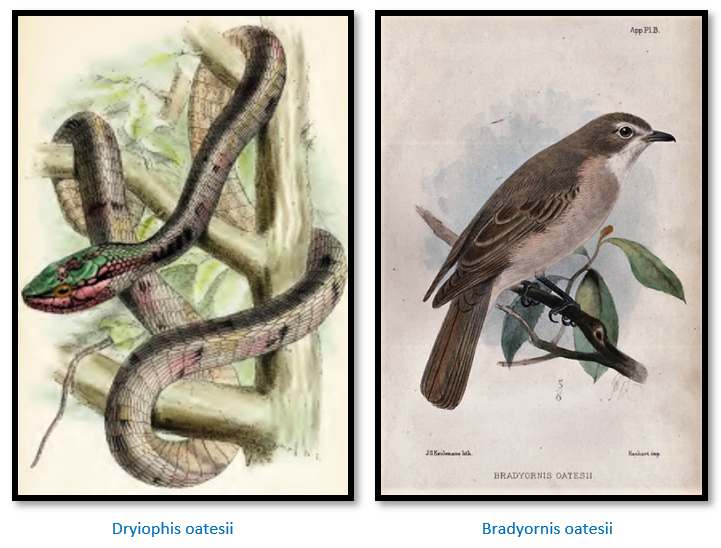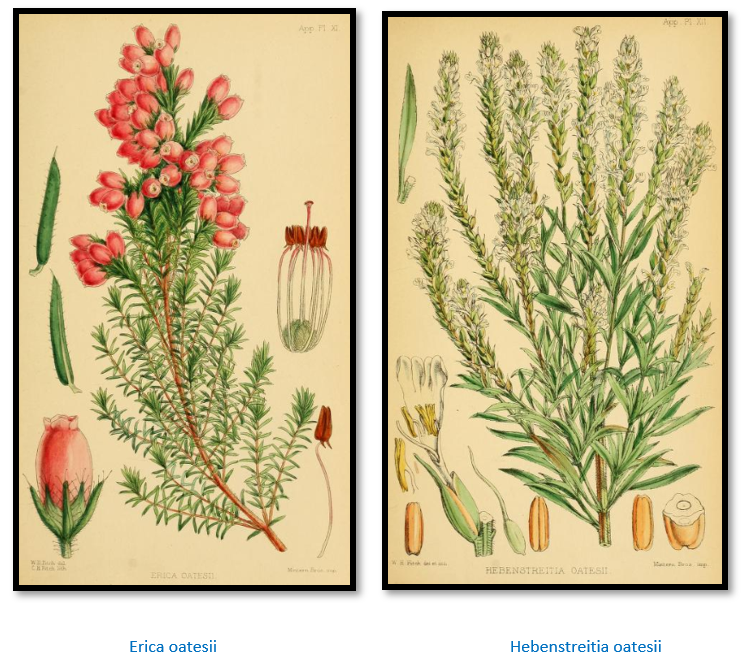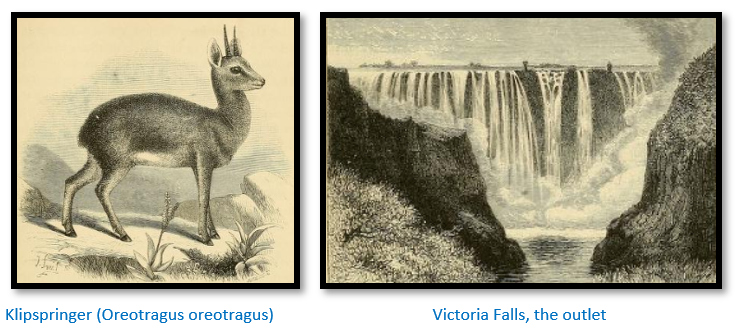Home >
Matabeleland North >
The naturalist Frank Oates who visited the Victoria Falls on 31 December 1874 and died only 36 days later of fever
The naturalist Frank Oates who visited the Victoria Falls on 31 December 1874 and died only 36 days later of fever
Frank Oates (1840 - 1875) was the quintessential Victorian naturalist; his discoveries are commemorated in the scientific name given to various species of “oatesii” and he was a reasonable painter of wildlife and scenery and a good amateur map-maker using a sextant to plot his position and an aneroid barometer to read and carefully record his altitudes, although both his painting and map-making were not in the same class as Thomas Baines.
Wikipedia say he was an explorer, but the Cambridge Dictionary describes the term as someone ‘who travels to places where no one has ever been in order to discover what is there.’ But this hardly applies in Oates’ case as Matabeleland and the Zambesi in the 1870’s were well-travelled by this time. They also say he was one of the first to see the Victoria Falls and he was certainly one of the first one hundred Europeans to view the Falls.
Most of the watercolours and sketches in Matabeleland and the Victoria Falls; the Diaries and Letters of Frank Oates 1873-75 were, as Charles Oates states in the Preface, in fact done by his brother William Oates. “Some are from sketches by the late Frank Oates; the remainder – and these the larger number – from those of his brother, W.E. Oates, who accompanied him during a portion of his journey.”[i]
The book which made Frank Oates famous was posthumously edited from his letters and journals by his brother Charles George Oates and published in 1881 with detailed descriptions of flora and fauna, plus drawings and maps based on Frank Oates’ observations. A second enlarged edition of the book was published in 1889 with appendices on the natural history collections by a range of experts. It is clear that Frank did not deliberately intend his writings to be published. The notebooks and letters were, as Charles highlights in the first edition’s Preface: “The latter were written with no view of publication; the former were intended only for the writer’s subsequent use and as suggestive guides to memory.”[ii]
His naturally poor health and his lack of any African experience in the ways of the Far Interior made for difficulties which more seasoned African travellers did not suffer; he was constantly having issues with his hired servants. He writes at Pretoria: “The niggers are idle and insolent. It is said the only way to treat them is to trash them well and though we have never resorted to this, I have often felt inclined to do so.”[iii] The negative attitudes were partly balanced by a tendency to always set himself challenges. He told his brother Charles: “I like anything that seems difficult of attainment”[iv] Charles Oates himself wrote that: “Life for [Frank] was no lounge, merely to be dreamed through, but an active, burning reality, from which the fruit that the hour yielded was to be plucked and harvested.”[v] However the natural and daily challenges of life in the Far Interior may have proved too much even for a person with Oates’ willpower.
Early Life
Frank Oates was born on April 1840 at Meanwoodside near Leeds and various biographers have described him as inheriting from his father, Edward Oates a wealthy lawyer and landed gentlemen, a ‘love of nature’ and ‘literary tastes.’ Although the original house is demolished, the grounds form Meanwood Park, a popular space in Leeds for families, walkers and dogs. Frank was three and half years at Christ Church, Oxford from 1860 reading Natural Sciences which had fascinated him since childhood, particularly bird-life and was physically involved in numerous physical activities including swimming, cricket, fencing and rowing as well as more outdoor sports such as riding, fishing, shooting and sailing.[vi]
However he suffered from a respiratory disease from his earliest days and combined with the mental strain of completing his final exams he suffered a complete breakdown in his health and left University before taking his degree.
For the next two years he lived a quiet life taking walks in Wales, the Lake District and Ireland and improving his skills as an artist, a talent that served him well on future expeditions when he was able to make detailed and accurate observations of the wildlife in his sketchbooks.
Gradually his health improved and on advice that he visit a dry, warm climate he spent twelve months of 1871-2 camping in the wilds of California, hunting buffalo on the Great Plains and meeting native Americans. From San Francisco he sailed to Guatemala collecting birds and insects until his funds ran out and on his return in 1872 he was elected a fellow of the Royal Geographical Society. Inspired by David Livingstone’s 1855 descriptions of the Zambesi river and Victoria Falls he was soon making preparations for a trip with his younger brother, William Edward to the Victoria Falls and the country north of the Zambesi river. In fact he was only three days at the Victoria Falls and never crossed the Zambesi river.
He was also uncle of the Antarctic explorer Lawrence Oates
Preparations at Pietermaritzburg - April 1873
The Oates’ brothers with William’s English servant, Thomas Bell, sailed from England on 5 March 1873. They were in Pietermaritzburg for about three weeks in April making preparations and bought two wagons with two spans of fourteen oxen, five horses, five dogs and far more food and trade goods than they would ever need, although they managed to sell the excess at a good profit. “We have large supplies with us, more than necessary, I think; but we can sell at Bamangwato what we do not want for nearly double what we gave for it at Maritzburg.”
They hired a driver, voorlooper and cook / general servant for each wagon and agreed to travel with T.E. Buckley whom they had met on the ship to South Africa and was equally inexperienced; at Pietermaritzburg they met Gilchrist who had hunted and traded in South Africa the previous two years and a young trader named Henry Gray who all agreed to travel together leaving Pietermaritzburg on 15 May.
Oates seemed to settle well into the routine of trekking saying: “Our waggons are most comfortable. We have a wooden framework in each waggon, surmounted by a substantial mattress and lots of blankets. We have tin wash-hand basins, cups and plates and fare luxuriously. Bell is now cooking some chops. I am reminded of some very pleasant days in the wilds of America.”
Arrival at Shoshong – July 1873
Travelling via Mooi River, Colenso, Ladysmith and Newcastle, Pretoria was reached on 30 June 1873. Oates claimed the town lacked even a book shop and he was not impressed with the inhabitants: "I fear the English who are here are a bad lot, with few exceptions. One man who cheated me I asked if he had a conscience. He replied that no one here had one."
At the Crocodile river on 5 July he wrote: “I rode up to the river, which is far the most beautiful thing I have yet seen in South Africa. Trees of various kinds – some resembling willows and oaks, the former in leaf, the latter bare – fringed the river’s banks, which are steep. Long grass and bush grew in the country around and where we outspanned at breakfast there was some very fine grass , tall and drooping, with a tassel. Here too, we got amongst plenty of birds and today is the first that I have felt the country cease to be disappointing.”
The road continued along the left bank of the Crocodile river until 24 July when they crossed the Notwane river, a tributary of the Crocodile and left the river and a few days later the blue tops of the Bamangwato hills came in sight and two days later they reached Shoshong, or Bamangwato as it was called at the time. The original plan had been to trek to Lake Ngami with Gray, but other travellers said the wells on the route had dried up; Gray planned to sit things out until the water situation improved, his companions decided to trek to Matabeleland instead.
The Reverend John Mackenzie gave the party a list of the waterholes between Shoshong and KoBulawayo and letters of introduction to Jon Boden Thomson who had in 1871 moved to the new mission at Hope Fountain. [see the article Hope Fountain under Matabeleland South on the website www.zimfieldguide.com] Mackenzie made a good impression on Frank Oates, but the brothers disliked Sekgoma 1, the Kgosi (meaning Chief) and were not impressed by the living habits of the BamaNgwato with William writing: “He had about a dozen dirty old wretches with him, who carried jackal’s tails and attend to him whenever he goes in state. He jumped up on Frank’s wagon and refused to depart until he had had some coffee given him, which Frank gave him to get rid of him. I offered him a bright green scarf I had, but after examining it carefully he returned it to me.” This was another example of their cultural insensitivities which they failed to overcome.
Journey from Shoshong – August 1873
Frank wrote at the same time: “We shall be glad to get away from here as it is difficult to get anything in the shape of food except what we have with us and what Gray gives us. There has been a scarcity of corn this year and the people are very hard pressed, living principally on locusts, which are brought in everyday in immense sacks carried on people’s heads. We buy water of the women, which has to be brought some distance.” They left Shoshong on 7 August; Buckley and Gilchrist tried a new route off the Hunter’s Road at the Seruli river, but finally gave up and reached Tati three days after Frank and William. The brothers met Boer hunters on the Mahalapye river who had shot rhinos, but no elephant. They bartered goat’s milk for tobacco at a kraal and at the Serule river drift met a group of San Khoisan hunter-gatherers and another group at the Khokwi river. Frank mentions ostrich eggs quite often in his journal, he comments that the eggs themselves were delicious fried with a little meal or made into a pudding with maizena with the empty shells used to carry water.
He describes the San Khoisan: “The people at the Gokwe are a sort of outcast race under the Basutos, called Bushmen. Men, women and children came to the wagon. They have fine pack-oxen. They live in the bush. Hendrik[vii] says having a temporary abode near the bed of the river to the left of the road. They were ornamented with beads and had on necklaces of blue cut ones and skins. They always ask for tobacco, making signs that they want snuff. They are hunting here. They brought ostrich eggs, exchanging them for a cheap knife, mirror or handkerchief. I had great difficulty in buying an ostrich feather for about three or four pounds of lead. They wanted a whole bar and on no other terms would bring more feathers.”
The wagons stuck in the bed of the Maklautsi river and they dug in the bed of the Shashe river to get water for the oxen. 24 August - “Trekked for three hours, then rested and started again at 11am…reached the Shashe about two and outspanned. We had come extremely slow, sun hot, sand heavy, road bad, bullocks tired. Ground broken and stony and falling toward the Shashe. Many crags crop up around and in front of us are some kopjes – Hendrik says where the Tati is. The Shashe is a very broad river, all deep sand with water in one place where it has been dug for, both for cattle and people. We enlarge the hole (hard work under the heat of the sun) and let the cattle drink. There is an old Bushman here, destitute and alone. He says the Mangwato men took his gun. The other side of the river he says is under Lobengula, this under Sekgoma and Hendrik says the Makalakas[viii] are not independent, all here belong to the Matabele and Mangwato sovereignties.
The Bushmen are, I suppose, the original inhabitants.[ix] Hendrik says they are slaves to the others. They certainly are outcasts. This man does not beg, takes what is given him and lies naked with his head on a stone by the fire at night. He has no blanket. Watched the Bushman make his fire with two sticks. He took off his sandals, placed a stick on one of them and holding it firm with his foot, twisted the other stick rapidly between both hands working it in a little hollow of the first stick, til black dust began to form. This soon turned red-hot and there was fire like that in a pipe.”
Even here Frank Oates is having problems with his servants. “I was in advance of William when I reached the Shashe and as it happened, had then only one man, Hendrik, my black servant with me, for my driver and his boy[x] had decamped, though they afterwards returned – as of course they were likely to do – the same evening. They will not have their wages paid til they return to Maritzburg and then not unless they have behaved properly and they would have had a miserable time if they had actually deserted me…the difference originated in the driver asking me for tobacco when I told him to inspan and refusing to comply till I had supplied him, which of course I would not do as I treat them quite liberally enough and indeed too well.”
A lion attacked an ox that night which had to be shot next day, but the lion was shot and wounded by Frank Oates; it died in the bush and the skin was brought to him by a San Khoisan at Tati which they reached on the evening of the 26 August. “Sunset very lovely. In the foreground brown bushes. Two little violet kopjes appear against the sky, behind one of which the sun has set. A lovely rose hue, deepest around the position of the sun is on the horizon, this fades into violet and this again into a pale greenish-blue. Some very small, clearly defined, deep violet clouds, edged with gold, stand out from the sky.”
Too late in the season to visit the Victoria Falls; William goes hunting and then leaves for England
The brothers were advised with the rains beginning in November the risk of fever would be high so they opted to visit Matabeleland instead. Both C.J. Nelson who represented the London and Limpopo Mining Company at Tati and Alexander Brown, a Tati trader, were helpful and hospitable to the brothers.
Buckley, Gilchrist and William Oates left Tati on 2 September for a shooting trip on the upper Shashani and Semokwe rivers. After a spell of good hunting they left on the journey south and were joined at the Marico river by Dawnay and Moore who had been at the Victoria Falls and hunted at Nwasha Pan. William wrote on 2 December 1873: “In coming from Mangwato we had to stop a week at the Marico as the river was very high with the rains and we couldn’t cross. I had some thoughts of taking my waggon in pieces and floating the things across on rafts, but the water kept subsiding and at last we got over, the water only just taking the oxen off their feet. In dry weather there is hardly any water, but after the rains the river gets tremendously swollen and there are very steep banks.” The party of five reached Pietermaritzburg on 2 January 1874 and Gilchrist and William Oates left for England.
Frank Oates travels to Matabeleland – September 1873
Frank left Tati on 31 August with the mails and in the company of a Cape Malay named Henrik who spoke good English. Their wagon stuck in the sand of the Ramaquabane river, but Petersen, a trader who worked for George Phillips, hauled them out with extra oxen. By 2 September they had reached the Umpakwe river. Oates’ oxen were weak after drinking brackish water and Petersen arranged with the Boer hunter Smidt living nearby to lend Oates extra oxen. They went together to John Lee’s farm where Smidt stayed and Oates rented his oxen as far as Makobi’s kraal at the Matabeleland boundary which was reached on 8 September.
3 Sept 1873 – Frank Oates writes: “Morning very chilly. Breakfast on biltong and butter; the fresh butter excellent. We branded and left ‘Rondeberg’ ‘Engeland’ and ‘Vinal.’ The Boer [Smidt] put twelve of his bullocks into my waggon, eight of mine in his and ‘Donker’ ‘Wikieman’ and ‘Spot’ were driven…trekked about twelve miles from the Umpakwe to the Ingwesi river and outspanned about 6pm.” Each individual ox in the span was named as the above indicates. This is another example of Frank Oates requiring help to get out of what might have been a tricky situation.
John Lee’s farm
6 Sept – “…Went on again at 5pm, the ground rising a little. Then as we descend a range of kopjes appears in front. In about an hour a pretty white farm is seen to the right, towards which the road winds and the wild view makes the farm seem to welcome one.
Lee came to meet me and asked me in. He is a fat red-faced man, his wife very young. His house has an air of comfort and some luxury about it owing to some handsome leopard karosses on couch and chairs. There was a picture too by Baines of Lee shooting three elephants. The horse here represented, which I think cost him £100, was the making of him, he tells me…Lee describes how his old favourite used to snuff when game was near and when it was elephant his manner was unmistakeable. He had tried donkeys in the tsetse-fly country, but the fly had always killed them…
I think he calls it ten miles to Manyame’s and from his (Lee’s) house to the King’s fifty odd miles. He says he saw some eland today, but game is not plentiful just here. However it is worse along the road to the King’s as kraals abound. Lee does not wish to have kraals near him and the King does not permit any to be made in his neighbourhood…His place he says is very healthy and it has got so good a name that in unhealthy times people stay about here and it has been like a town, so that he opened a store…
He says an elephant gun should never be longer than 27 inches (25 is better) nor weigh over 9 lbs. He shoots 8 drams of powder and an 8 to the lb ball [8 bore] The recoil is avoided by the barrel being strong and nearly as thick at the muzzle as at breech. His clothing in hunting is as light as possible; veldskoens and he says not even a shirt if he could help it. He carries needles and thread in his hat.
For trading with the Matabele he recommends white, blue and I think, red beads. Selampore[xi] is much liked, or strips of coloured calico…” Oates is being tutored in hunting and trading by the old seasoned veterans such as John Lee.
Held up at Makobi’s kraal but given permission to travel to koBulawayo
“Soon after our arrival Manyame came attended by another old fellow, each in a shabby old hat and vying with each other in squalor and dirt.” Frank Oates gave Manyama a bar of lead and requested that he send at once for permission to enter Matabeleland. [For a map see the article on the Hunter’s Road under Mashonaland West on the website www.zimfieldguide.com] “He refused firmly to send to the King til tomorrow saying the King had not sent for me, but I had come of my own accord and must not be in a hurry; the oxen could feed and rest.” The two messengers to Lobengula were given a note to James Fairbairn requesting that he send oxen to replace those of Smidt. They were back three days later with the King’s permission and eight replacement oxen from Fairbairn. Four days later on 15 September Oates was in koBulawayo.
9 Sept – “The night had been very mild. Old Manyame came bothering early. In the course of the day he kept on coming and I gave him twenty gun caps. Wonder of wonders, he afterwards presented me with a pumpkin and I felt less hostile to the old creature. He is really a miserable-looking, ugly and filthy creature. Stayed about waggon again today.” The amaNdebele shocked him by creating an uproar at his wagon throughout the final journey with their begging, bargaining for produce or trying to collect fines from him for alleged trespass and setting of veld fires. His naivety and lack of cultural awareness were becoming a personal problem.
11 Sept – Two days later he writes: “I like the Matabele better than I did. They are good-natured and jovial and seem to understand a joke. There were great firings and noises at the kraal in the evening, in honour it appears, of a man returned from the diamond-fields.”[xii]
14 Sept – “…Starting again at 4pm we next went over rising ground, the country getting very clear of timber and at half-past six stopped at a small spruit with water in it, having crossed two previously. A long, dry, treeless plain here stretched before us, with kopjes rising into range against the horizon. It seems the spruit we are now out-spanned at is the head-waters of a river flowing into the Limpopo and where we were outspanned this morning is the headwaters of the Kumalo river which flows into the Zambesi.”
During the whole trek since Shoshong Oates has been quoting local information given to him by Hendrik, his black driver, and clearly he is writing down what he is being told as an aide-memoire.
Visits the King and makes plans for a first visit the Victoria Falls
Oates outspanned at Fairbairn’s wagon kraal on 15 September and was taken by Fairbairn with Petersen to see the King whom he found very civil. Oates presented a shotgun and cartridges and was given permission to visit the Victoria Falls. After which Fairbairn and Oates took the mail to Rev Thomson at Hope Fountain Mission.
From Hope Fountain Oates wrote on 25 September 1873: “I cannot give you a detailed account of my stay of nine days at the King’s Town. It is really to a stranger a most curious place. The king, Lobengula, lives in royal state. He is absolute monarch and feared and obeyed far and wide. The people inhabiting the country we have passed through in coming here are altogether of an inferior race. At Bamangwato there is a king, but he is thought nothing of. I called on ‘Bengula, accompanied by Fairbairn, the day I arrived here, and found him the picture of a savage king, just as one might have imagined, and coming quite up to the standard. The day I first saw him he was nearly naked, and lying on a skin inside his hut, to enter which you have to crawl in on your hands and knees through a little aperture in the front; in fact, it is like a beehive entrance. He took me by the hand, and placed meat before me, and asked a few questions about my journey. I told him I should come again next day. Of course I had to make him a present, and I knew he would expect it next day, after which I should ask his leave and assistance to go through his country to the Victoria Falls if possible. I gave him a gun and ammunition, which pleased him very much, and he has done everything he could for me.
It appeared that I was still in time to reach the Falls by going on foot, after leaving my waggon at the place marked on the map as Inyati. The king said it was possible to get to the Falls in ten days, and I suppose at my rate of travelling it ought to be done in a fortnight or three weeks at most, and the king says I have still two months of favourable weather, but so anxious is he that no white man should come to grief in his country, that he has been urging on me all possible haste from the moment the subject was first mentioned. He has given me two excellent men as guides; these two, having the king’s authority, will carry all before them.
I left Gubuluwayo last Night, and came on as far as here, the house of Mr Thomson the missionary, for my first trek. Mr Thomson has kindly interested himself in me and done all he could to assist me. He has a nice wife and children, and this morning I have had the luxury of a civilized breakfast, including tablecloth, bread and butter and eggs, and milk to one’s coffee – things that I don’t often see now. I am now availing myself of one of his rooms to write to you.”[xiii]
One of the two guides was a royal cousin named Macloule, and whilst making plans Oates saw an impi returning from a raid on Mashonaland led by an izinDuna Umtigan in European clothes and on horseback with hundreds of captured cattle and spoke to an old English sailor, John Halyet who was building a brick house for Lobengula. Oates spent the night with Thomson at Hope Fountain whilst Macloule went ahead to collect twenty to thirty porters. Next day he walked to Inyati, now Inyathi Mission in unusually cold and wet conditions where he met Frank Mandy, one of two traders with a store at Inyati and hunted with him whilst waiting for the porters.
However, it soon transpired that the porters could not be obtained, or possibly as Eric Tabler suggests, Lobengula had become aware that Frank Oates health was not that robust and decided not to run the risk of an Englishman dying on the Zambesi of fever.[xiv] In its place Lobengula offered Oates an area to hunt instead.
Journey to the Ingwenya river – October 1873
Oates left Inyati on 7 October travelling east and bartered food, ostrich eggs and feathers for trade goods. On the 9 October he crossed the Shangani, on the 10 October the Vungu, where he saw elephant tracks for the first time and on 11 October the Gwelo, now Gweru river where he met a Cape Malay named Nelson who had only killed fourteen elephants and a few ostriches in two months of hunting because he said they had been driven them away by local natives. Oates travelled on beyond the Ingwenya river on the Hunter’s Road but local people told him that he had passed an area the day before that had elephants, so he returned to an area southwest of the Gwelo river where he met Nelson again who told him he had just shot two bulls from a herd of forty elephant. He stayed in the area until the 27 October finding little game with the days getting progressively wetter.
He writes: “A boa-constrictor [African rock python] six feet six inches long and as thick as my wrist lay its length upon the ground and was skilfully transfixed by one of my boys’ assegais and pinned to the ground. The lads were evidently afraid of his bite, but the men say that it is harmless…The Mashonas use these snakes as an article of food.”[xv]
He moved to a new camp north of the Hunter’s Road on the Vungu river for three weeks where he, or his men, killed an elephant with tusks weighing 54 lbs (24 kgs) each. The rains showed no signs of letting up, so he returned to Inyati by 23 November and had problems there paying off his servants before reaching Fairbairn’s store on 4 December.
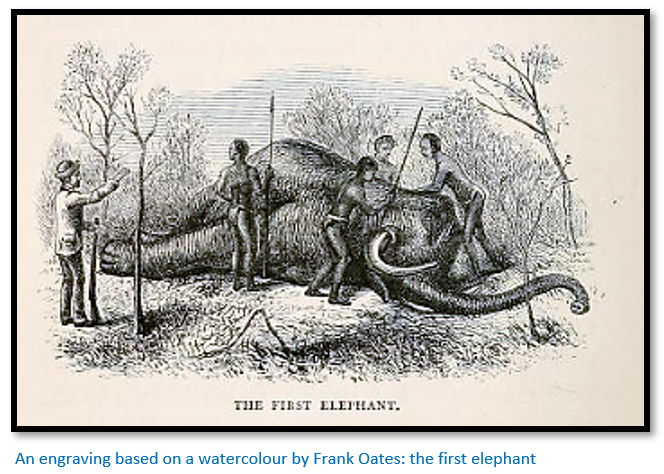
Oates prolonged stay at koBulawayo – 1873 / 4
Oates remained at the amaNdebele capital until 26 January 1874. He had intended to stay only until 8 January to see the Inxwala (Incwala or the First Fruits Celebration) but the weather made the country too wet to travel and he was also delayed by his Natal servants with more disputes over pay. John Lee helped Oates settle these disputes with his servants with the King as umpire. Lobengula sold him some ivory and in turn Oates sold Lobengula his salted horse[xvi] and then had to add the saddle and bridle as well. He had Christmas dinner with Petersen, then he, Petersen, Frank Mandy and Fairbairn had New Year’s dinner with the Thomson’s at Hope Fountain.
“The fine hot day and the luxuriantly green country and rapidly-growing Indian corn make it seem more like June than New Year’s Day to me. Petersen, Fairbairn and Mandy went to Thomson’s in cart and we sat down to a most excellent dinner – roast and boiled mutton, potatoes, cabbages and turnips, plum-pudding and mince-pies.”
There is a description of the Inxwala beginning the 4 January when participants arrive for the dance. Festivities began on 5 January and built up to 8 January the day of the Great Dance. Oates provides a detailed description of the dancers, male and female, which are described in a number of other accounts. Of Lobengula Oates writes: “The king is dressed much like his warriors and looks himself. He is fine-looking and has an agreeable expression and a ready smile. He is one of the darkest-complexioned people I have seen belonging to this nation.”[xvii] There is dancing on a lesser scale on 9 January and a number of bullocks are slaughtered on the 10 January: “I saw a dozen or twenty down, or being assegai’d” but the numbers slaughtered appear to be less than in previous years. The following day Lobengula leaves in his wagon. “There were twelve black, or nearly black bullocks in the royal waggon and when it started the throne was carried – as it always has to be done – on a boy’s head. It is a straight-backed, substantial and extremely plain green chair with red daubs on it. Over the back and seat is stretched a piece of lion-skin.”
22 Jan – “Fairbairn had a row in trading with the King, who had chaffed him a good deal last night. A large quantity of ivory had come in (Fairbairn was here by the King’s express desire to trade) and a small tooth had been put down before him. He made his offer for it which did not satisfy the King. Fairbairn said: ‘It is a small tooth.’ ‘Did you ever shoot as large a one?’ asked the King. This is considered a poser. Then a hot argument ensued between Fairbairn and the King, the King maintaining that Fairbairn would show unequivocal signs of fear at the sight of an elephant. Fairbairn said white men were not afraid of them; whereupon the King cited H-, a big man, who had not even shot a little calf; W- ‘where are the elephants he shot?’…but in the meantime the King had offered Fairbairn two small teeth for a double-barrelled gun, less than cost price and Fairbairn had left the King in disgust.”
However on 24 January Oates noted: “Fairbairn, Lee and I to the King. Fairbairn does a good trade with him after the row.”
25 Jan – “The scene with the King sitting on his front-box would make a picture; the setting sun, the dark green trees beyond the kraal and the green walls of the newly-erected kraal; the yellow beehive-like huts, the yellowish trodden grass in the space, the herds of goats and sheep with lambs and kids and packs of dogs crowding round the King’s waggon; the groups of natives, some all but naked, some adorned with feathers, some with a single article of European dress, as a hat, crouching on their haunches, forming the court of the black King; tusks of ivory lying about. To complete the picture, a white trader or two should be introduced, not above crouching before his sable majesty who sits there in his broad-brimmed black felt hat, pipe in mouth ( a small briar-root, worth perhaps 2d. at home) cotton shirt not over clean, unbraced baggy trousers and large clumsy shoes, a benignant smile generally on his black face.”
Hunting in the Tati district – February 1874
Oates planned to trek to Shoshong and refit there for his trip to the Falls, but the trip to Tati was very slow as his wagon kept getting stuck and the resultant strain on the disselboom resulted in its breaking. 31 Jan – “The sun was getting low as we inspanned. We soon came to a very bad place – a huge pit in fact – where the road had been, to avoid which we had to go through a very soft piece of ground into which the waggon sank deep and I thought it was a case of a regular stick, but Vincent got me out of this well and showed his great superiority as a driver.” Once again rescued by a fellow traveller returning from koBulawayo with an empty wagon and Oates wrote home saying: “The journey here is about three days under ordinary circumstances, but it took me six in the present heavy state of the country and badness of the river drifts. I had many sticks in the mud and breakages of my disselboom. Last night I arrived here and today is Sunday. The man to whom I am going to give this letter [Vintcent] drove my waggon for the last eleven miles. He overtook me on the road and let his own empty waggon go on. We were about six hours in accomplishing the distance, but thanks to his timely help, I pulled through.”
At John Lee’s he found the hunter Smidt and two wagons delayed on their journey to James Dawson. Oates hired Karel Lee as a driver to Shoshong and they set out towards Tati. The rivers were in flood and Oates became stuck in the Inkwesi river; “The boy [voorlooper] who was leading the front oxen let go the strap he held them by and we had a great deal of trouble.” Smidt came up naked from wading the river “in the unadorned garb of nature” and took over as driver. “…This plain extends far to the west and north, but to the north-east is again broken by kopjes in the direction of the Mangwe, whilst the fine craggy hills of the Inkwesi rise nearer in the same direction. Some delicious fruits, not unlike greengages, known by the natives as ‘marula’ were picked up about here on the march.”
Whilst shooting in the vicinity of the Umpakwe river on the Hunter’s Road Oates examined the little ruins. “Here is some distant stonework forming a circular wall, inside which are remains of bricks coated with a substance as if smelting has been done here. No mortar has been used and the work is rough and I should say of no great antiquity, the stones being small and loose and easily displaced so that I think they would not stand any great length of time. They are cut in an oblong form and properly placed for building. Karl [Smidt] says it was made for smelting copper and used by the people Moselekatze found here. That it is any older I should much doubt. Shot here a beautiful sun-bird whose beauty awoke my slumbering love of ornithology.”
Oates visited the graves of Firmin, a young sportsman killed by the first elephant he saw in early 1869 and of another Englishman who died of fever; both were buried on the banks of the Ramaquabane. Smidt returned to Mangwe because the hunting was poor and Oates arrived at Tati three days later.
From Tati he wrote to William on 24 February: “It is quite a pleasure to get a letter from you, I mean the one you left for me here. I shall get no more now for five or six weeks, when I expect to be in Mangwato. I am sorry that wretched old croaker, Palmer,[xviii] put you in a funk about me. He says it would be a good thing for people travelling to have ‘portable coffins’. I am thankful to say my health is excellent. I did not, as doubtless you know by this time, get to the Zambesi. I believe the king was at the bottom of it (not of the Zambesi; but excuse grammar). I took my waggon fifty miles on the way, as far as Inyati, and then put all out for fifteen carriers to take. It was a fortnight’s walk through ‘the fly’ to the Falls. After waiting nearly a week, it transpired that no boys were forthcoming as promised. Partly, I think, they were afraid of fever, and partly of the natives, with whom they are at war; partly also they wanted to get in time to cultivate their gardens. However, I believe I could have got them myself easily, had I not trusted to the man given me by the king.”[xix]
Ethnographic Material collected by Oates
A lot of Oates ethnographic background knowledge is dubious, for example after negatively comparing the Bechuanaland scenery with that of North and Central America he states: “Perhaps one reason that the North American Indians were for savages a superior race was their fine scenery.”[xx]
There is no doubt that the sketches of headdresses, native weapons, musical instruments, wooden pots and pillows are extremely useful, but his collection of a number of skulls of dead ‘Bushmen’ [San Khoisan hunter-gatherers] killed by the amaNdebele a year or so earlier would be considered tasteless and insensitive today, although it was considered relevant scientific research at the time.
Smidt had told Oates that not far up the Ramaquabane river a number of San Khoisan hunter-gatherers had been killed the previous year by the amaNdebele and Oates decided to collect their remains. But then Smidt found a reason to return to John Lee’s and Klaas, the guide, similarly made an excuse. 18 Feb – “Last night Klaas (the Hottentot) told me he was going on to Tati today being too unwell to accompany me in my excursion in quest of the bones, but would leave me his Bushmen – the one he had sent for from Tati, who knew the place and the one he has had with him here. The former was out hunting when his fourteen companions – men, women and children – were killed at their hunting kraal by the Matabele. He found them all dead on his return. It seems they were a party of Mangwato Bushmen and some of them had taken meat belonging to some Bushmen from Manyami’s. The latter complained to the King who said the Mangwato Bushmen were to be killed. This was last winter.” Despite the local people being reluctant to guide Oates to the location later in the year he succeeded in collecting some remains.
Van Rooyen took Dorehill and Oates to the location on 15 November 1874. “Van Rooyen seemed a bit nervous and indeed was rather perplexed to find the place, however at last he did…Heaps of ashes and game bones, broken pots and other remains lay around amongst which the skulls of the Bushmen appeared conspicuously. We found three here and three more lay in the grass at some little distance. We off-saddled and collected some bones which I tied up in order to carry on my saddle in front of me…”
These remains were brought with the remainder of Oates’ collections to England after his death and sent to Oxford University for detailed examination and cranial measurement.
Oates joins a hunting party on the Semokwe river – February 1874
The hunting party consisted of Piet Jacobs, Frank Oates and Klaas, a Khoikoi hunter he met journeying from Bulawayo, Francis and John Garden, two newly arrived English sportsmen, Henry Wall, a Griqua hunter later employed by George Westbeech and numerous San Khoisan trackers and guides. Jacobs, Oates and Klaas each had a wagon, the Garden brothers had three wagons. Lions had been harassing Piet Jacobs cattle; he hunted down and shot a lion with dogs; another was killed with a trap gun.
The combined party moved up the Ramaquabane river on 24 February and crossed below the Umpakwe confluence crossing the Ingwesi and going due east across the Sansukwe to the Simukwe or Simokwe river where a camp was set-up about 6 kms below the Simukwe’s confluence with the Mangwe river from where they hunted on horseback. The longest trip about 15 kms downstream and 24 kms east to the Shashani. They found many rhino, buffalo, zebra and giraffe, but also eland, kudu and other antelope. The return trip was begun on 5 March and they were back at Tati by 17 March 1874.
Journey to Shoshong – April 1874
At Tati Oates paid off Karel Lee who returned to his father’s farm and set off on 4 April for Shoshong with Fred Selous, James Fairbairn and James Dawson. The Hunter’s Road had dried up after the rains, there was plenty of grass and water for the oxen and the journey was completed in a week. Reverends John Mackenzie and James Hepburn advised him not to use the Western Old Lake Route to Nwasha Pan and the Zambesi Valley which though shorter than the Westbeech Road from Tati was much drier. He laid in a stock of maize meal, brandy and coffee, but could get no sugar.
In a long letter he wrote to the family dated 16 April 1874 he writes: “…There are besides the party I have enumerated [Selous, George Wood, Garden brothers, Bond] a lot of Boer hunters going to the Zambezi with their wives and families. Those who go by Tati will leave it about the middle of May. I think the Falls can be reached and seen and you can be returning in August if you wish to leave so soon.” If Frank Oates had followed this advice and not been delayed there is a good chance he might not have caught malaria and died. A few days later a couple of wagons arrived from Lake Ngami with two traders both looking dreadfully ill from fever and the ominous news that Henry Gray, the trader who had accompanied the brothers when they first left Pietermaritzburg, had died from fever.
Frustration with his wagon
With his six Mashona and San Khoisan servants and driver named John he left Shoshong on 24 April for Tati but the second day a wheel broke on a stretch of rough road and was hauled back to Shoshong on a sledge made of branches and dragged by six oxen. The repair took time and when the journey was resumed on 5 May the tire of the same wheel broke after just six hours of travelling. The wagon was taken back to Shoshong and sold; two wagons were bought with additional oxen to the twenty-six he already had.
At Shoshong he met the elder Van Rooyen with his son Johannes Cornelis and they were hired to drive, manage the servants and hunt on halves for ivory. They left Shoshong on 13 May; at the Maklautsi drift they saw the tracks of two lions but the elder van Rooyen deliberately lost the spoor as he knew of no good reason to hunt them. They arrived at Tati on 21 May. Piet Jacobs was present, Hugh Dobbie was working on the Bluejacket Reef, Alexander Browne was looking after the London and Limpopo Mining Company’s interests as Nelson had gone south. Oates spent time caring for Browne who was ill and having the wagon wheels strengthened.
Second attempt to journey to the Victoria Falls – June 1874
James Fairbairn arrived at Tati and told him that Lobengula had given permission for Oates to go to the Zambesi. Twelve persons had been given permission in 1874 and most were already on their way. Henry Bond and Robertson, two English sportsmen had left from Shoshong in February by the Western Old Lake Route. Soon after Piet Jacobs took his whole family to hunt in the Zambesi Valley before returning to their Tati house by 16 October. Stoffel Schinderhutte left for the Zambesi in February, far too early and lost his driver and other servants to fever. Selous and George Wood joined forces with the Garden brothers left Tati with Henry Wall on 6 May and hunted from a camp on the Deka river headwaters before viewing the Falls and then hunting on the Chobe river.
Many other traders including William Horn and his partner, George Gordon, George Dorehill and others were prevented from entering Matabeleland by an outbreak of redwater disease; the amaNdebele border was moved south from Makobi’s kraal to the Ingwesi river.
Oates left Tati on 9 June with the van Rooyen’s. They hunted on the Ramaquabane river and on the 12th the elder van Rooyen killed a lion that attacked his horse. They passed over the headwaters of the Shashe and were at Wankee’s kraal on 18 June where they were halted by the headman as Lobengula had sent orders that all wagons were to be halted until October because of the redwater outbreak. Oates started back to Tati in order to go to koBulawayo and seek permission from the King to trek north. By 25 June he was at Tati and then forced to wait at the Ingwesi river for permission to travel onwards; Dorehill and Oates were given permission on 5 July.
Lobengula declared he had forgotten to exempt Oates whose cattle he knew were not infected and gave him Manyame’s son as a guide to conduct him through the Bakalanga towns. Oates’ driver John then quit his job and the van Rooyen’s left because Oates as fallen out with the elder van Rooyen. At the same time Schinderhutte came south from the Zambesi and Oates hired him on condition he was conducted to the Falls and back again in return for one of Oates’ wagons and ten oxen.
Start again for the Victoria Falls – July 1874
They left Tati on 25 July in the evening and whilst hunting on the Ramaquabane were told there was a new order from the King to stop wagons. Manyame’s son would not insist that Oates was exempt, so he and two other servants were sent to koBulawayo to establish the facts. The messengers returned saying all was in order and Oates and Schinderhutte started north on 10 August and were at Wankee’s kraal in ten days. Schinderhutte injured his finger which became infected and he then left for Hope Fountain for Rev Thomson to treat. Oates had purchased maize at the Bakalanga kraals and one of the wheels of the overloaded wagon broke into pieces on the first stretch.
His driver Klaas and three servants were sent to Tati with the wheel asking Browne to have it fixed and Oates spent a miserable two weeks being pestered and bullied by the Bakalanga after Manyame’s son left for his kraal. He was unable to leave his wagon for fear everything would be stolen and when Klaas returned with a wheel, Oates decided it was too late in the winter to start for the Zambesi and travelled back to Tati arriving on 18 September.
Third attempt to the Victoria Falls – November 1874
Oates occupied Piet Jacob’s empty house until he returned on 16 October. Lobengula had given him permission to hunt on the Shashani [see the map above] but he could not leave at once as he was ill and the wagon needed repairs. Schinderhutte whose finger had been amputated returned with Dorehill and invited Oates to join them on a trip to the Zambesi. They planned to hunt along the Westbeech Road until April or May 1875 and go the Falls when it was safe to do so. Oates hesitated and then agreed to join and they left Tati on 3 November 1874.
Ten days later where the Westbeech Road left the Ramaquabane to cross to the Tati river they met Jacobs and the elder van Rooyen going south and the two Boers tried to persuade Oates not to go further, but without success. It was here that Van Rooyen took Dorehill and Oates to the spot where the San Khoisan hunter-gatherers were killed. The three were not hindered on their way through the Bakalanga kraals in the way Oates had been on his previous trip and they reached the Maitengwe river on the 15 November at the same time as a party of Griqua hunters, former employees of Schinderhutte, trekked down with their wagons from the north. At Menon’s kraal, Oates’ mare died of horse sickness. [See map 5 in the article George Westbeech and the road to Pandamatenga under Matabeleland North on the website www.zimfieldguide.com]
17 Nov – “Out with two boys shooting….during the ride I saw a big game-drive made by the Makalakas consisting of a long broad alley, the sides composed of large tree branches forming a strong hedge. At the end were three pits side-by-side walled around with stakes. On the top were placed light stakes and long grass was laid over all. My boys say the Makalakas kill lots of quagga and other game in these traps.”[xxi]
24 Nov – “A rabbit got up close [probably an African savanna hare (Lepus victoriae)] to the waggon directly after we outspanned and the dogs set off. Dorehill lost one of his and I lost ‘Rock.’ Our boys found the spoor and as it turned out the dogs had been stolen by Makalakas. Stoffel, Dorehill and I with Jacob rode with our guns and a lot of boys to two or three kraals threatening them all with punishment until the dogs were given up. At night they were brought back by one of Stoffel’s and one of Dorehill’s boys who had been to a kraal and demanded them.”
30 Nov – “Cloudy morning; close, hot afternoon…On returning from the veldt in the evening found everyone who had been left at the waggons nearly drunk; the Griquas rushing about with loaded guns and fighting. Inspanned to restore order and went about four miles.”
At the Maitengwe drift they met Selous and Wood trekking south and they warned Oates he was taking a big risk heading to the Zambezi valley at this time, but by now he was determined to see the Victoria Falls as soon as he could, with or without Schinderhutte and Dorehill. Selous and Wood advised him that December to March would be safer at the Falls than April but having waited eighteen months during which he had endured many trials he would not take good advice. George Dorehill however listened to the hunters and turned back and went south with them reaching Tati on 11 December.
Schinderhutte left at the Maitengwe drift with another trader he met on 1 December with Oates following two days later accompanied by John Mackenna, a Cape Malay. They soon caught up with Schinderhutte and trekked through heavy sand to Tamasetsi vlei [Map 8 of the George Westbeech and the road to Pandamatenga article] where Schinderhutte stayed and Oates and Mackenna pushed on to Pandamatenga.
The huge baobab tree which Oates passed by was described by Fred Barber; “Hunting in the neighbourhood for four or five days and finding no fresh elephant spoor we continued our journey towards the Zambesi passing the fine pools of Thamafipa and Tamasetsi and a little further north The Big Baobab Tree well-known to all travellers passing that way by its enormous girth. [see the article Frederick ‘Freddy’ Hugh Barber, hunter, trader, artist – visited the Victoria Falls in 1875 and Matabeleland in 1877 under Bulawayo on the website www.zimfieldguide.com] Alfred Cross and Barber measured this tree: “Its stump was nearly eighty feet in circumference at the ground and although to outward appearances quite healthy, the inside had rotted out leaving a comfortable room in which travelling natives slept about ten feet in diameter. A Dutch hunter with his wagon and family joined us here and travelled with us.”
The same Baobab tree is described by Oates in his journals: "The tree was perfectly gigantic in girth, thickening as it got higher, though of no great height. It was swollen and bloated in a most extraordinary manner ... Though still flourishing, it was a mere shell, and, looking in at a hole in the side, I saw that it was open to the sky at the top. Inside is a good-sized chamber, strewed with minute bones of rats or some small Mammalia. No doubt generations of owls have long had their abode here; one flew out at our approach."
George Blockley and Dr Benjamin Bradshaw were at Pandamatenga. Shortly after crossing the Deka river Oates waggon stuck in a very soft muddy place and George Blockley who was then in charge of the trading station came with a span of oxen to help him out. Also at Pandamatenga was Dr Bradshaw. George Westbeech was at Sipopa’s in Barotseland. On 24 December, the traders James Truscott and his partner Wilmore arrived, both ill with fever.
Christmas Day was celebrated at the store by the cooking and eating of a large plum-pudding and next day Oates busied himself preparing for his walk to the Falls. Oates had persuaded Dr Bradshaw to guide them to the Victoria Falls; Oates took eight of his servants, Bradshaw took four and Mackenna took three and they walked to the Falls in five days arriving on 31 December 1874.
27 Dec – Pandamatenka: “I am just about to set off to walk to the Victoria Falls which are only three days from here. This place is somewhere about fifteen miles to the north-westward of Deka, a place you will probably see in any recent map. Neither place is a town of any sort but each is merely a river flowing to the Zambesi. At both rivers waggons stand, as they are both out of ‘the fly.’ The place where I now am is quite civilised, as it is a trading station and the man in charge here has a snug little house, well-thatched to keep out the rain. He has lived here three years, and is in the employ of Westbeech, who is at present at the residence of Sipopa, the Zambesi chief, some distance up the river. His man Blockley, undertakes the charge of my effects whilst I proceed to the Falls.
You will be delighted to hear that there is a doctor here who is going to accompany me on my walk and is a great stickler for comforts….He spends a good portion of his time in collecting beetles and is very good-natured. He never loses an opportunity of telling you that a thing is very unwholesome, the next thing being its rapid disappearance into his own interior. There was a grand plum-pudding made here on Christmas Day. Besides Blockley and the doctor there are two traders [Truscott and Wilmore] who arrived here after I did on their way to the Zambesi. One has been ill and the doctor prohibited him plum-pudding, so there were four of us in all. We ate nothing but pudding on Christmas Day and the day following with scarcely an exception. The men had another pudding. My man turns out to have originally been a cook and when he likes can cook well. The doctor was found to be five pounds heavier after dinner on Christmas Day…There was a grand idea of taking a lot of plum-pudding with us on our walk, but the last morsel disappeared last night. However we shall not be badly off for supplies.
…This must be a comparatively healthy spot, even in the most unhealthy time as it overlooks the flat wet country around it and the water will run from it. There appeared to be much more watery land and more pools of water about Deka than here. It is where so much land lies under water that, about the end of the rainy season, the fever is so bad. People may get it almost any time, but February, March and April seem to be the worst months…
One of my goats was reported to have been killed by a leopard on Christmas Eve. We all went with our guns and I took my dogs. We found the unfortunate goat lying dead, a live companion standing over it, and also standing over it and facing the live goat, an animal I thought was a dog. They told me it was the leopard, but I would not fire still thinking it a dog. At last however I saw what it was and we shot it. Two others ran away and my dogs killed both of them gallantly and in next to no time. They were cheetahs, a sort of leopard, very lanky and a good deal like greyhounds in appearance…”
In his Journal Oates records each day of the walk in detail until the 31 December when stopping to shelter from a heavy shower just above the river they caught their first sight of Mosi-oa-Tunya, "The Smoke That Thunders" through the trees and a halt was ordered for the night.
Frank Oates recorded in his diary, “After breakfast, I visited the Falls - a day never to be forgotten” as the Zambesi river was in full thundering flood unusually early that year. This brief and understated description seems rather a disappointment today as no further entries were made in his journal until 14 January 1875 when he was again back at Pandamatenga. After sketching and painting the Falls they began the long walk back to Pandamatenga. How sad that Frank Oates died only 36 days after reaching the Victoria Falls.
Death of Frank Oates
Westbeech arrived from Barotseland soon after to take the ivory he had collected south to Shoshong and Oates and Mackenna joined him as they left Pandamatenga on 19 January. Two of Oates’ servants already had fever and on 25 January at Gerufa, north of Nwasha pan, Oates complained of a slight headache, one of the first symptoms of malaria. Within two days he was well enough to hunt, but the symptoms of fever grew worse as they progressed south and by the 29 January his colleagues were alarmed by his condition. Westbeech and Dr Bradshaw did their best and tried to hurry their patient on to Tati. His condition seemed to improve, but deteriorated in the afternoon and just north of Wankee’s kraal Oates died on the evening of 5 February 1875 aged just 34 years old.
The ground was too hard to dig a grave as the party had no digging tools and when they heard Piet Jacobs was buying grain nearby they sent Jan Mackenna, also weak from fever, to ask for help.
Jacobs told them to bring the body further down the road which they did to learn that he had found an old game pit about eight feet deep near the road about 3 kms south of Wankee’s kraal on the banks of the Tjwigwetjane river. Oates was buried here with his grave marked with a cairn of stones and Westbeech and Bradshaw began the journey with his wagon and collection of specimens to Shoshong to be left in the care of Rev Mackenzie.
Frank’s two dogs, Rock and Rail had survived the journey but after some time it was noticed that Frank’s favourite dog Rail was missing. After retracing their steps Rail was found sitting at his master’s grave, a fine example of the loyalty between Frank Oates and his dog. Both dogs returned to England with Gilchrist. Five years after his master’s death Rail died on 5th February 1880 and three weeks later his companion, Rock, also died.
After reaching Shoshong Bradshaw returned to Pandamatenga and Westbeech went south to Klerksdorp.
Gilchrist brings Frank Oates collections from Shoshong
William Oates and Gilchrist left England to join Frank Oates on a trip to the interior on the day that he died. They reached Durban on 15 March and were about to go upcountry when news came of Frank’s death. William returned immediately to England leaving Gilchrist to travel north to collect Frank Oates’ belongings and take a headstone for his grave.
Gilchrist arrived at Tati with his two wagons on 18 July but was refused permission to go further as his oxen were from Natal and might be carrying redwater disease. However Piet Jacobs was at Tati and had permission to enter Matabeleland at any time as his oxen had never been south of Shoshong. He took Gilchrist to the gravesite which was five days trekking from Tati and Gilchrist put up the headstone before leaving for Shoshong and gathering Oates’ collections of animal skins, birds, reptiles, insects, plants and ethnological items from Rev Mackenzie.
However quite a large quantity of specimens were destroyed during Frank’s lifetime when the hut in which they were stored at Shoshong lost its roof during a rainstorm and according to Charles some spirit jars of reptiles and beetles were mistakenly left behind when the collections were conveyed to England.
William Oates
William continued to make hunting trips to Africa using his gun to add to his collection of animal specimens including waterbuck, wildebeest, zebra and white rhinoceros, plus many species of birds which adorned his home as trophies and some of which were donated to the British Museum and he continued drawing watercolours of African scenes. His appetite for travel and adventure continued after Frank’s death and included trips to India and America and a yachting trip to Spitzbergen above the Arctic Circle.
In later life William was remembered as an energetic member of a special committee set up by the Royal Geographical Society to conserve African wildlife. The RGS being ahead of its time in demanding government grants to establish special hunting free areas to protect and preserve endangered animals.[xxii]
The travels ended when William went on a holiday to Madeira with his wife and four children and died on 3 April 1896 after a very short time from typhoid and was buried on the island.
Frank Oates commemorated
It is fitting that his life which was cut short at the young age of 34 years is remembered both through the book which his younger brother Charles, a barrister, put together from his notes, diaries and letters and through the Gilbert White and Oates Collection Museum at Selborne which commemorates Frank as well as his nephew Lawrence Oates. Despite his life-long ill health Frank Oates used the time that was given to him as a positive and beneficial gift.
Finding Frank Oates grave
The website ice-tracks.com gives the following information saying the grave is difficult to locate. In 1934, a member of the Oates family asked the Pioneers and Early Settlers Society in Bulawayo to locate Frank Oates grave which was done with the help of James Haskins who had a trading store nearby. The cairn of stones could be located, but the white headstone that Gilchrist brought from Natal was gone. In 1935 an iron cross with a circular plaque was cast by H.G. Issels of Bulawayo as well as railings to protect the grave from elephants. This is in a similar style to the Pioneer Memorial Crosses ordered in 1910 by the Loyal Women’s Guild. [See the article The Loyal Women’s Guild and the Pioneer Memorial Crosses under Harare on the website www.zimfieldguide.com]
In 1945, Frank Oates, another member of the family contacted the same Society as he wished to visit the grave of his great uncle. Sir Robert Tredgold, then Judge President of Rhodesia helped in the search to locate the grave and following a 10 year search the grave was “refound” in 1955 by R Tapson, Native Commissioner at Plumtree, with the help of an old Kalanga man, Leburu, who guided him to the site. When Tredgold and Tapson re-visited the site a very old African man appeared who told them that he had erected the cross and later the railings on the instructions of a policeman from Francistown. [The grave is on the Botswana side of the Botswana / Zimbabwe boundary]
However, the old African man pointed to a mound of rocks some 50 yards away and stated that Oates’ original burial place lay under the mound and not under the railings. During a heavy storm some years later floodwaters eroded open the mound exposing human bones and with the help of two locals the remains of Frank Oates were interred within the area of the iron railings and plaque erected by the Pioneer Society and Early Settlers Society.
Animal and Plant Species named after Frank Oates
In the second edition of the book Matabele Land and the Victoria Falls; the Diaries and Letters of Frank Oates 1873-75 R.A. Rolfe revised the botany and added a number of species. These include:
the Vine Snake Dryiophis oatesii and a sub-species Thelotornis capensis oatesii,
a number of plants: heather Dryiophis oatesii, Euphorbia oatesii Rolfe, Lippia oatesii Rolfe,
Erica oatesii,
And a beetle Dromica Oatesii
Interestingly Eugene William Oates (1845 – 1911) no relation to Frank, was also a keen naturalist and has many species also named oatesii that originate in India and Myanmar and the Andaman Islands.
The above illustrations are by R. Mintern.
Fellow travellers and residents met on the journey
George Blockley – called ‘little George’ by Africans to distinguish him from George Westbeech. Trader, storekeeper, hunter entered Westbeech’s employ in 1871 and went to the Zambesi that year where he was in charge of the trading stations for the next sixteen years. Probably the longest residence of any European in the Zambesi Valley. Often travelled to the Barotse Valley in 1875 taking Holub to meet Sipopa at Sesheke and was with Sipopa at his death in 1876. He conducted the Jesuits to the Falls and Lesuma in Barotseland in 1880. Assisted the missionary Arnot in 1882 and facilitated his entry into Barotseland. He was at Lesuma in 1884 and assisted the explorers Schulz and Hammar up the Chobe river. He met Lieut Bethel and Trooper Ayton of the Bechuanaland Border Police at Pandamatenga in 1886 and died in August 1887. He was a good-natured friendly man liked by all and very helpful to travellers and on the best of terms with all the chiefs.
Dr Benjamin Bradshaw – once a doctor on board an American steamship, he quit for the diamond fields and towards the end of 1872 joined Westbeech as an assistant. He and Blockley were at Pandamatenga when Oates arrived in late December 1874 and guided him there and back. About mid-January Westbeech arrived from Sipopa’s and the three together with Mackenna started back for Tati. Bradshaw and Westbeech turned Oates’ property over to Rev Mackenzie at Shoshong at the end of February. He was at Pandamatenga in 1875 and went to the Transvaal with Westbeech from February to May 1876. He was at Pandamatenga throughout 1877 – 8 and left the Zambesi in May 1879 having been at Pandamatenga for seven years and managed the trading station in Blockley’s absences. He went to England in 1880 but returned becoming a surgeon to the Bechuanaland Border Police where he died in 1883. He was a good doctor and collected birds and insects as a business and was a keen naturalist.
Alexander ‘Sandy’ Brown – a Scot who arrived at Tati in 1869 and managed the store for the Glasgow and Limpopo Company which later also became the post office. He collected bird skins which he sold to museums and collectors. He married the daughter of the hunter Piet Jacobs in 1876 at Hope Fountain by Rev Thomson and left for Klerksdorp in July 1879. Described by all ‘as a gentleman by birth and education.’
James Fairbairn – initially an agent for Cruikshank at koBulawayo; after 1875 he traded on his own account and obtained a mineral concession from Lobengula in 1884 with his partners Phillips, Leask and Westbeech. This was subsequently sold to the British South Africa Company and Fairbairn was at koBulawayo in 1893 when the BSAC’s force invaded Matabeleland.
Henry Gray – had been trading for the previous four years in South Africa. He set off before the others with five heavily-laden wagons and they did not meet again until they reached Shoshong. Gray died the same year of fever at Lake Ngami.
Gilchrist – he had hunted and traded in South Africa for two years prior to the Oates’ brothers arrival in April 1873. In 1875 he went upcountry to Shoshong to collect Frank’s wagon and belongings and erected a stone headstone on the current Botswana / Zimbabwe border to mark Frank’s grave. He was at Tati on 18 July 1875 and was stopped there on Lobengula’s orders because of an outbreak of redwater – a life-threatening disease to cattle caused by ticks. Piet Jacobs who was resident at Tati with his family in the 1870’s took him to the grave where he erected the headstone and then returned to Tati before taking Frank Oates’ collections to Durban for shipment to England.
Pieter Jacobs – born about 1800 he started hunting as soon as he could manage a large bore muzzle-loader. He was at Lake Ngami in 1851 and hunted for ivory in the country bordered by the Botletle and Chobe rivers until 1857. In 1859 he and Viljoen killed 93 elephants east of the Makgadikgadi salt pans. In 1865 Mzilikazi permitted them to hunt in Mashonaland and they went as far as the Mupfure river killing 190 elephants, including 47 in one day. In 1866 he was at the Zambesi with Viljoen and in 1869 hunting the lower Shashe river with William Finaughty. In the 1870’s Jacobs and his family lived at Tati; in 1872 he was badly mauled by a lion near Iron Mine Hill in Mashonaland. He was back at Tati in 1873 and hunted at the Maitengwe river. Next year he was one of the hunting party on the Semokwe river with Oates. In 1875 he was buying grain near the Bakalanga villages when Oates died on 7 February and he helped to bury him. In July he took Gilchrist to Oates grave. In 1882 he retired to the Waterberg district of the Transvaal and died about 1882. One of the greatest African hunters; it is estimated he killed between 400 – 500 bull elephants in his lifetime.
Jan or John Mackenna – a Cape Malay who had been to India and South America as a steward in sailing ships and an officer’s servant in the Cape Mounted Rifles, now a hunter, wagon driver and conductor. In 1874 he was hunting in western Matabeleland with Selous and Wood; at the end of November Oates hired him to be his wagon conductor to the Zambesi.
Reverend John and Ellen Mackenzie – The Mackenzie’s missed the fated Makololo Mission because Ellen was pregnant and they stayed at the London Missionary Station at Kuruman in Robert Moffat’s absence. In May 1862 Mackenzie and his wife were appointed by the LMS to Shoshong. They had hoped with John Moffat and Roger Price to reopen the Makololo Mission, but Shoshong was attacked by the amaNdebele in March 1863 when only the Mackenzie family were present.
Two months later the Mackenzie’s and John Moffat’s with Hand Hai left for Matabeleland. They passed the ruins of many BamaNgwato kraals burnt by the amaNdebele and were held up at Manyami’s kraal because Mzilikazi suspected they had assisted the BamaNgwato against his men. The Mackenzie’s stayed six months in Matabeleland and Mzilikazi offered Mackenzie a choice of mission site, but he felt he could work more usefully amongst the BamaNgwato and returned to Shoshong where he was resident for the next twelve years and was well-known by all the European traders and hunters as he acted a postmaster.
Frank Mandy – based in Grahamstown, he made the first of six annual trading trips to Matabeleland in 1870 sometimes travelling up to Mashonaland to sell supplies to hunting parties. He knew all the early explorers such as Baines, Selous, Dorehill and Wood. He hunted for a short spell in September and October 1873 with Frank Oates and had dinner with him at Hope Fountain on New Year’s Day. He left the country early in 1874 and brought in trade goods in late 1875. In 1881 he was managing an ostrich farm near Port Elizabeth and in 1890 he enlisted as a lieutenant in B Troop of the Pioneer Column. He worked for De Beers as a compound manager and died at Kimberley in 1903.
C. J. Nelson – a Swede managing the gold mine of the South African Gold Fields Company. Oates thought there were about seven men resident at Tati at the time. Later hired by Sir John Swinburne as manager at Tati for the London and Limpopo Mining Company.
T. Petersen – either German or Danish, he worked for George Phillips and assisted Frank Oates in his 1873 journey to koBulawayo. By 1875 he was in partnership with Meyer and on his birthday gave a dinner for the other Europeans Cross, Elstob, Grant and Hudson in koBulawayo. He is recorded as being at koBulawayo in 1875 – 7, he had a store at Hope Fountain in September 1877.
Christoffel ‘Stoffel’ Schinderhutte – by 1873 had been several years in the interior employed by Phillips and Westbeech. Made many journeys between the Zambesi and Tati including taking Frank Oates and Dorehill from Tati in November 1874. Stoffel was a heavy drinker as were many of the traders and hunters based at Pandamatenga and Shoshong, about the only social activity available to them. In July 1875 he left from Shoshong with two wagons of trade goods for Westbeech at Pandamatenga. One wagon broke down and whilst waiting in Shoshong for it to be repaired he went on a drinking binge and by the time he left had the classic symptoms of alcoholic brain damage. He shot some oxen in their yokes, knocked a driver off a wagon so he was run over and killed and shot the voorloper dead. Then he rushed off into the bush where he either died naturally, or was killed by wild animals, or friends of his victims. The wagons were looted of their goods; Stoffel’s veldskoens and part of his beard were found and identified at Shoshong.
Epitaph
Charles Oates writes in his Memoir: “As, one after another, the packing-cases were opened, each in its turn afforded to the looker-on some fresh illustration of the untiring determination of the deceased traveller to make the very utmost of his opportunities abroad. The voice that could alone have told the story of these collections, the hand that had brought them thus together, were silent and still in a far distant grave…”
References
F. Oates (C.G. Oates, Editor) Matabele Land and the Victoria Falls; the Diaries and Letters of Frank Oates 1873-75. Kegan Paul, Trench and Co, London 1889
E.C. Tabler. The Far Interior. A.A. Balkema, Cape Town 1955
E.C. Tabler. Pioneers of Rhodesia. C. Struik (Pty) Ltd, Cape Town 1966
Thoresby Society
Gilbert White’s House & Garden and The Oates Collection Museum, The Wakes, High Street, Selborne, Hampshire.
Wikipedia
Notes
[i] Oates, P17
[ii] Ibid, P15
[iii] Ibid, P41
[iv] Ibid, P27
[v] Ibid, P28
[vi] Ibid, P22
[vii] Hendrik is described by Frank Oates as ‘my black servant.’
[viii] Bakalanga people of Western Zimbabwe
[ix] Frank Oates is correct. See the article Modern Humans originated from Botswana, the ancestral homeland for all anatomically modern humans today, but left due to climate change under Matabeleland North on the website www.zimfieldguide.com
[x] The voorloper
[xi] Serampore an Indian city which manufactured a blue cotton cloth
[xii] Oates, P68
[xiii] Ibid, P63-4
[xiv] E.C. Tabler, The Far Interior, P396
[xv] Oates, P82
[xvi] Rev Thomson told him this would please the King who would be grateful, although Oates later regretted that he was persuaded to part with his horse
[xvii] Ibid, P99
[xviii] Grey Palmer, a hunter and trader. His newly married wife Agnes, just 23 year old arrived in Matabeleland on 17 February 1875 and died at Hope Fountain Mission on 4 March. See the article on Hope Fountain Mission under Matabeleland South on the website www.zimfieldguide.com
[xix] Oates, P141
[xx] Oates, P36
[xxi] Ibid, P179
[xxii] Smith, P14
When to visit:
n/a
Fee:
n/a
Category:
Province:

